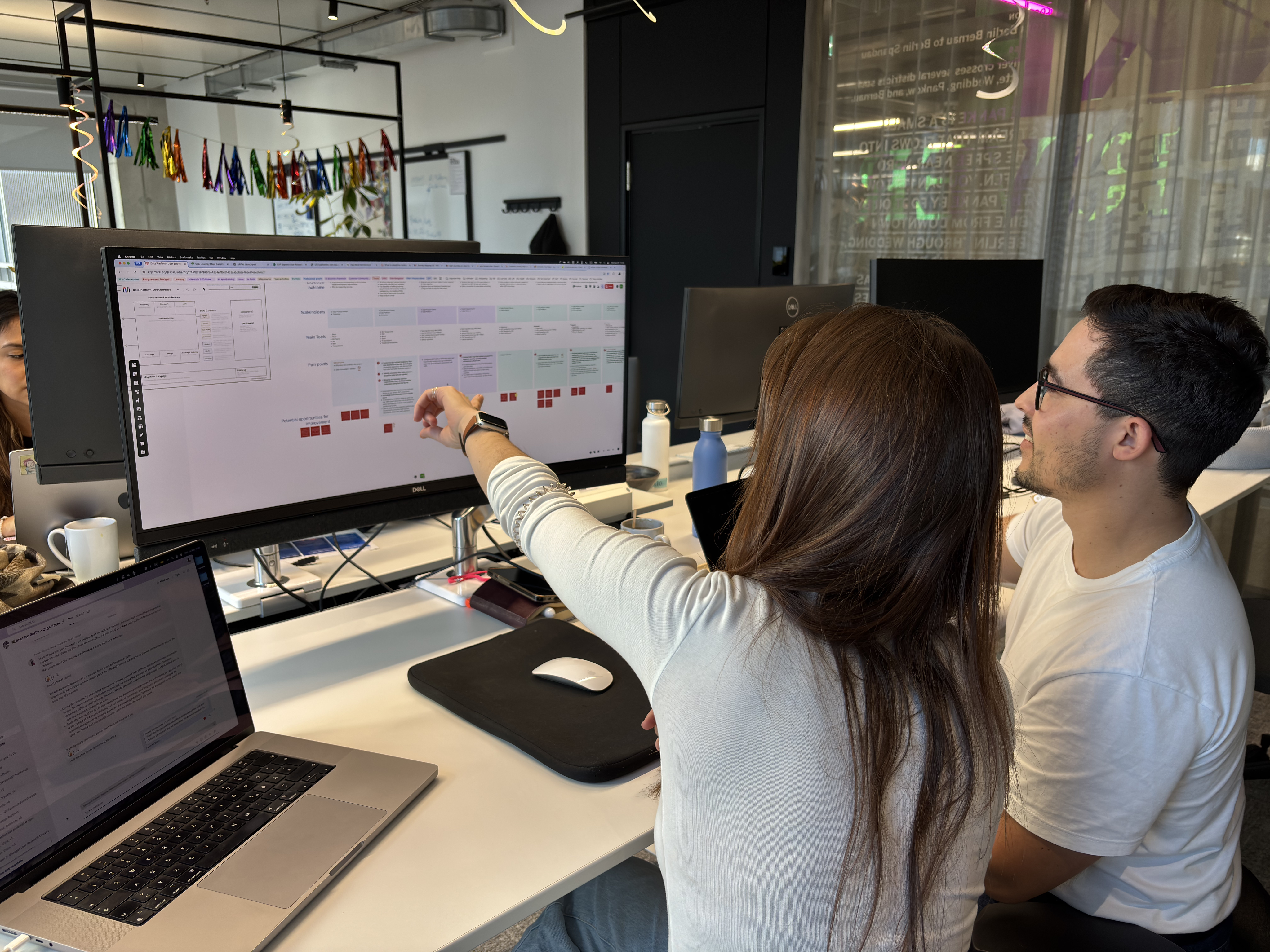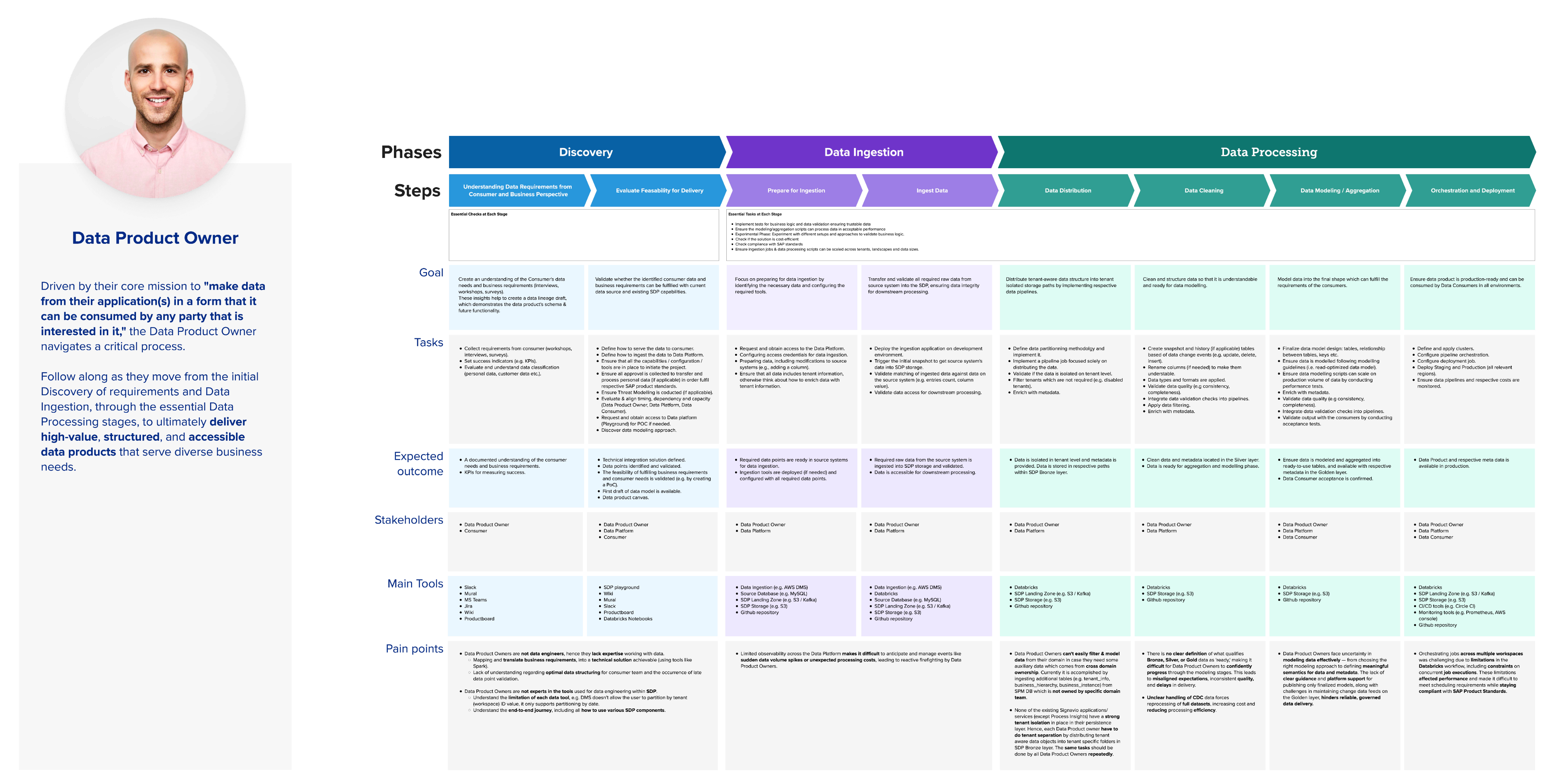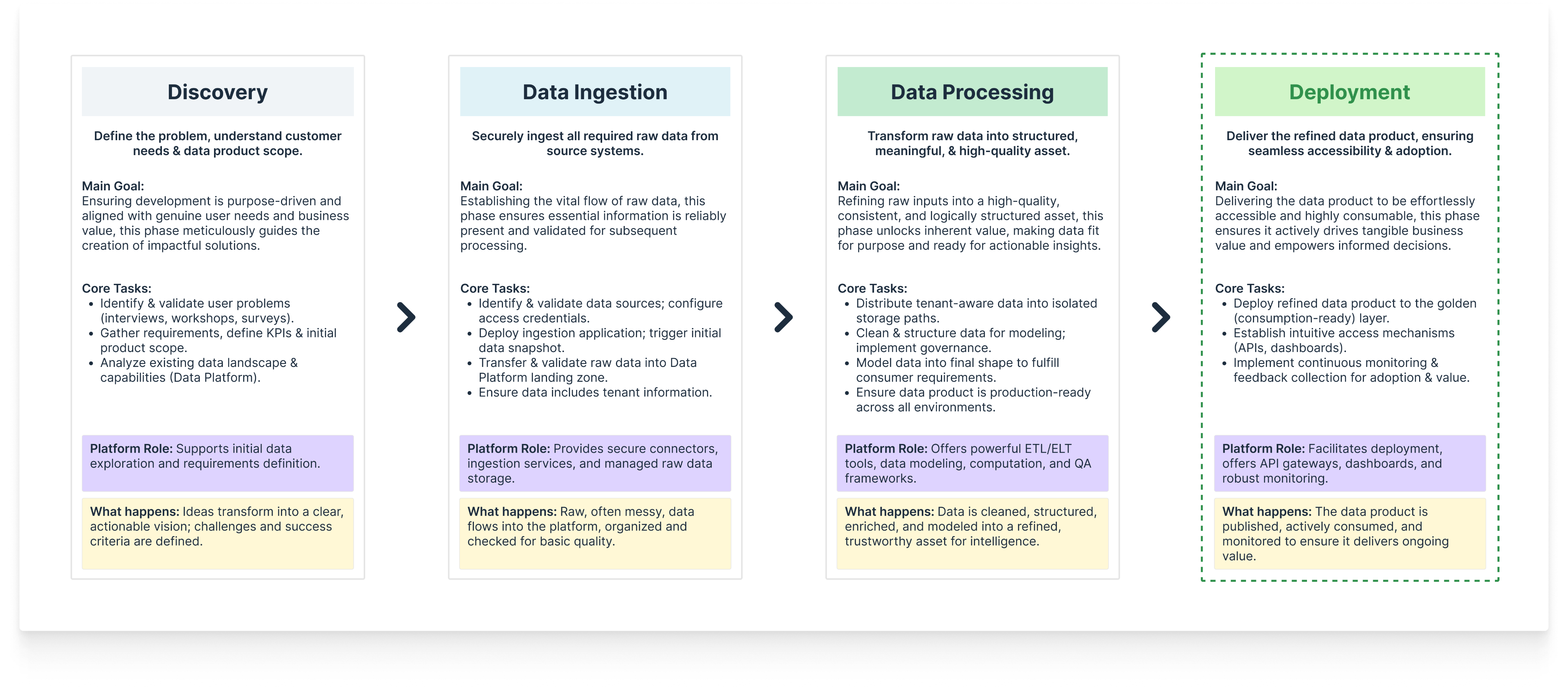Also worth exploring
More projects

Building a User-Centered Foundation for SAP’s Platform
On a high-stakes enterprise data platform at SAP, the platform was being built without putting users at the center. Decisions relied on assumptions and internal opinions, creating risk and misalignment. Through user-centered research, we delivered the first validated journey map, a single source of truth that aligned product, design, and engineering around real user needs.
The Challenge
A key product team at SAP was developing a complex data platform without putting users at the center.
Decisions were based on assumptions, creating a high risk of building the wrong solution and wasting significant engineering effort.
My Role
As the UX Researcher within a cross-functional product team, I was responsible for leading this foundational research initiative.
Outcome
We delivered the first-ever validated User Journey Map. This artifact became the team's single source of truth, creating a shared, evidence-based understanding that aligned product, design, and engineering, and provided a clear framework for user-centered prioritization.
The investment in this new platform was significant, but we were operating in a vacuum of user knowledge. Product decisions were driven by conflicting internal anecdotes, creating a state of misalignment between product, design, and engineering.
This exposed us to critical business risks:
Vacuum of User Knowledge: No validated understanding of user workflows or pain points
Conflicting Internal Data: Decisions based on assumptions and anecdotes
Team Misalignment: Product, design, and engineering pulling in different directions
I identified the urgent need to mitigate these risks and defined a clear objective:
to replace assumptions with evidence by creating the first validated User Journey.
This would be the foundation to ensure we were building the right product, for the right person, in the right way.
To replace assumptions with evidence, we designed a qualitative, two-phase research plan focused on mapping and validating the user journey. This approach allowed us to uncover hidden pain points, align stakeholders, and create a robust foundation for user-centered decision-making.
Phase 1
Individual Discovery (Diverge): We began by conducting 1:1 in-depth interviews with key experts. This allowed us to capture a rich, unfiltered view of the process from multiple perspectives.


Conducting a 1:1 discovery session with experts. These deep-dive interviews were the bedrock of the entire project, allowing me to capture the unfiltered reality of the user's workflow.
Phase 2
Collaborative Validation (Converge): In partnership with Product Manager, Product Owner and Lead Engineer, we then facilitated a collaborative workshop where the same experts reviewed, debated, and refined the draft journey together. This co-creation process was crucial for ensuring the final artifact represented a unified "source of truth" and generated immediate buy-in from key stakeholders.
The session didn’t just validate the journey — it surfaced shared realizations and shifted perspectives, capturing how this moment of alignment reshaped our understanding of user needs and product priorities.
Our research culminated in the creation of the first validated user journey map for this domain — a detailed blueprint of the user’s process. It documented goals, main tasks, expected outcome, and pain points across every step of the workflow.
The “Aha!” moment was uncovering the massive pain point around manual data validation — a step within the Data Processing phase that was previously invisible to the team and became the foundation for reshaping our roadmap and prioritizing automation.

The detailed User Journey Map — our team's single source of truth. (Details blurred to protect confidentiality)
To make this complexity digestible for stakeholders, we also created a high-level overview of the journey.
This simplified framework broke the workflow into four key phases, giving the team a common language and an easy way to discuss the end-to-end process.

The four key phases of the user's journey. This high-level framework provided our team with a common language and a simple structure to discuss the complex end-to-end process.
The journey map wasn't just a research report, it was a tool for change. It became foundational to how our team operated and made decisions.
Shared Understanding
Established a common language across Product, Design, and Engineering, grounding all feature conversations in user reality.
Prioritizing What Matters
Quantified pain-point severity to de-prioritize the "real-time dashboard" (saving 2 sprints) and prioritized a new "Automated Data Validation" feature that directly addressed the biggest user need.
Working Smarter
Drastically reduced assumption-based stalls by providing a validated, shared reference for every product decision.
This project was a powerful reminder that a researcher's true impact comes not just from gathering data, but from synthesizing it into a clear strategic direction.
The journey map's greatest value was immediate team enablement. By making the synthesis process collaborative, we ensured our cross-functional partners achieved alignment before the final artifact was delivered.
By equipping our teammates with the clarity and confidence to make evidence-based decisions, we were able to move past internal debates and prioritize a validated roadmap, ultimately enabling the team to build the right thing faster.
Also worth exploring

Building a User-Centered Foundation for SAP’s Platform
On a high-stakes enterprise data platform at SAP, the platform was being built without putting users at the center. Decisions relied on assumptions and internal opinions, creating risk and misalignment. Through user-centered research, we delivered the first validated journey map, a single source of truth that aligned product, design, and engineering around real user needs.
The Challenge
A key product team at SAP was developing a complex data platform without putting users at the center.
Decisions were based on assumptions, creating a high risk of building the wrong solution and wasting significant engineering effort.
My Role
As the UX Researcher within a cross-functional product team, I was responsible for leading this foundational research initiative.
Outcome
We delivered the first-ever validated User Journey Map. This artifact became the team's single source of truth, creating a shared, evidence-based understanding that aligned product, design, and engineering, and provided a clear framework for user-centered prioritization.
The investment in this new platform was significant, but we were operating in a vacuum of user knowledge. Product decisions were driven by conflicting internal anecdotes, creating a state of misalignment between product, design, and engineering.
This exposed us to critical business risks:
Vacuum of User Knowledge: No validated understanding of user workflows or pain points
Conflicting Internal Data: Decisions based on assumptions and anecdotes
Team Misalignment: Product, design, and engineering pulling in different directions
To address these risks, we set a clear objective:
put users at the center by replacing assumptions with evidence.
This would be the foundation to ensure we were building the right product, for the right people, in the right way.
To replace assumptions with evidence, we designed a qualitative, two-phase research plan focused on mapping and validating the user journey. This approach allowed us to uncover hidden pain points, align stakeholders, and create a robust foundation for user-centered decision-making.
Phase 1
Individual Discovery (Diverge): We began by conducting 1:1 in-depth interviews with key experts. This allowed us to capture a rich, unfiltered view of the process from multiple perspectives.


Conducting a 1:1 discovery session with experts. These deep-dive interviews were the bedrock of the entire project, allowing me to capture the unfiltered reality of the user's workflow.
Phase 2
Collaborative Validation (Converge): In partnership with Product Manager, Product Owner and Lead Engineer, we then facilitated a collaborative workshop where the same experts reviewed, debated, and refined the draft journey together. This co-creation process was crucial for ensuring the final artifact represented a unified "source of truth" and generated immediate buy-in from key stakeholders.
The session didn’t just validate the journey — it surfaced shared realizations and shifted perspectives, capturing how this moment of alignment reshaped our understanding of user needs and product priorities.
Insight
Our research culminated in the creation of the first validated user journey map for this domain — a detailed blueprint of the user’s process. It documented goals, main tasks, expected outcome, and pain points across every step of the workflow.
The “Aha!” moment was uncovering the massive pain point around manual data validation — a step within the Data Processing phase that was previously invisible to the team and became the foundation for reshaping our roadmap and prioritizing automation.

The detailed User Journey Map — our team's single source of truth. (Details blurred to protect confidentiality)
To make this complexity digestible for stakeholders, we also created a high-level overview of the journey.
This simplified framework broke the workflow into four key phases, giving the team a common language and an easy way to discuss the end-to-end process.

The four key phases of the user's journey. This high-level framework provided our team with a common language and a simple structure to discuss the complex end-to-end process.
The journey map wasn't just a research report, it was a tool for change. It became foundational to how our team operated and made decisions.
Shared Understanding
Established a common language across Product, Design, and Engineering, grounding all feature conversations in user reality.
Prioritizing What Matters
Quantified pain-point severity to de-prioritize the "real-time dashboard" (saving 2 sprints) and prioritized a new "Automated Data Validation" feature that directly addressed the biggest user need.
Working Smarter
Drastically reduced assumption-based stalls by providing a validated, shared reference for every product decision.
This project was a powerful reminder that a researcher's true impact comes not just from gathering data, but from synthesizing it into a clear strategic direction.
The journey map's greatest value was immediate team enablement. By making the synthesis process collaborative, we ensured our cross-functional partners achieved alignment before the final artifact was delivered.
By equipping our teammates with the clarity and confidence to make evidence-based decisions, we were able to move past internal debates and prioritize a validated roadmap, ultimately enabling the team to build the right thing faster.
Also worth exploring

Building a User-Centered Foundation for SAP’s Platform
On a high-stakes enterprise data platform at SAP, the platform was being built without putting users at the center. Decisions relied on assumptions and internal opinions, creating risk and misalignment. Through user-centered research, we delivered the first validated journey map, a single source of truth that aligned product, design, and engineering around real user needs.
The Challenge
A key product team at SAP was developing a complex data platform without putting users at the center.
Decisions were based on assumptions, creating a high risk of building the wrong solution and wasting significant engineering effort.
My Role
As the UX Researcher within a cross-functional product team, I was responsible for leading this foundational research initiative.
Outcome
We delivered the first-ever validated User Journey Map. This artifact became the team's single source of truth, creating a shared, evidence-based understanding that aligned product, design, and engineering, and provided a clear framework for user-centered prioritization.
The investment in this new platform was significant, but we were operating in a vacuum of user knowledge. Product decisions were driven by conflicting internal anecdotes, creating a state of misalignment between product, design, and engineering.
This exposed us to critical business risks:
Vacuum of User Knowledge: No validated understanding of user workflows or pain points
Conflicting Internal Data: Decisions based on assumptions and anecdotes
Team Misalignment: Product, design, and engineering pulling in different directions
To address these risks, we set a clear objective:
put users at the center by replacing assumptions with evidence.
This would be the foundation to ensure we were building the right product, for the right people, in the right way.
To replace assumptions with evidence, we designed a qualitative, two-phase research plan focused on mapping and validating the user journey. This approach allowed us to uncover hidden pain points, align stakeholders, and create a robust foundation for user-centered decision-making.
Phase 1
Individual Discovery (Diverge): We began by conducting 1:1 in-depth interviews with key experts. This allowed us to capture a rich, unfiltered view of the process from multiple perspectives.


Conducting a 1:1 discovery session with experts. These deep-dive interviews were the bedrock of the entire project, allowing me to capture the unfiltered reality of the user's workflow.
Phase 2
Collaborative Validation (Converge): In partnership with Product Manager, Product Owner and Lead Engineer, we then facilitated a collaborative workshop where the same experts reviewed, debated, and refined the draft journey together. This co-creation process was crucial for ensuring the final artifact represented a unified "source of truth" and generated immediate buy-in from key stakeholders.
The session didn’t just validate the journey — it surfaced shared realizations and shifted perspectives, capturing how this moment of alignment reshaped our understanding of user needs and product priorities.
Our research culminated in the creation of the first validated user journey map for this domain — a detailed blueprint of the user’s process. It documented goals, main tasks, expected outcome, and pain points across every step of the workflow.
The “Aha!” moment was uncovering the massive pain point around manual data validation — a step within the Data Processing phase that was previously invisible to the team and became the foundation for reshaping our roadmap and prioritizing automation.

The detailed User Journey Map — our team's single source of truth. (Details blurred to protect confidentiality)
To make this complexity digestible for stakeholders, we also created a high-level overview of the journey.
This simplified framework broke the workflow into four key phases, giving the team a common language and an easy way to discuss the end-to-end process.

The four key phases of the user’s journey — our simplified framework for alignment. This high-level view gave the team a common language to discuss a complex end-to-end process.
The journey map wasn't just a research report, it was a tool for change. It became foundational to how our team operated and made decisions.
Shared Understanding
Established a common language across Product, Design, and Engineering, grounding all feature conversations in user reality.
Prioritizing What Matters
Quantified pain-point severity to de-prioritize the "real-time dashboard" (saving 2 sprints) and prioritized a new "Automated Data Validation" feature that directly addressed the biggest user need.
Working Smarter
Drastically reduced assumption-based stalls by providing a validated, shared reference for every product decision.
This project was a powerful reminder that a researcher's true impact comes not just from gathering data, but from synthesizing it into a clear strategic direction.
The journey map's greatest value was immediate team enablement. By making the synthesis process collaborative, we ensured our cross-functional partners achieved alignment before the final artifact was delivered.
By equipping our teammates with the clarity and confidence to make evidence-based decisions, we were able to move past internal debates and prioritize a validated roadmap, ultimately enabling the team to build the right thing faster.
Also worth exploring
